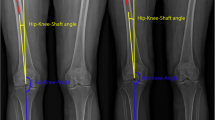Abstract
Purpose
Slipped capital femoral epiphysis (SCFE) represents the most common disorder of the hip in adolescents and a preliminary stage of degenerative joint disease. Up to now, functional outcome evaluation measured by objective instruments has been commonly neglected. The present study investigates whether the pathoanatomy of the hip joint after SCFE—analyzed on a standard X-ray—match functional results gained by three-dimensional gait analysis. A variation of functional outcome depending on the radiological findings after growth arrest is hypothesized.
Methods
Thirty-seven SCFE patients after growth arrest [mean age 18.5 years, standard deviation (SD) 4.61] with unilateral affection were included. The pathoanatomy of the hip joint was classified according to the radiological index of Heyman and Herndon and to aspherity. Three-dimensional gait analysis parameters were evaluated and subgroup analysis was performed according to the radiological results.
Results
The radiological findings revealed very good results in general (average comprehensive index of Heyman and Herndon 94 ± 9 %, aspherity grade <2). Significant deviations of gait parameters in relation to the radiological result were an increase in step width, sagittal range of motion (ROM) of the pelvis and foot progression for the worse subgroup.
Conclusions
Taken as a whole, the pathoanatomy of the hip joint after SCFE matched the functional results gained by gait analysis. Functional outcome varied slightly depending on the radiological findings after growth arrest. Differences were most pronounced for foot progression. Only with the help of gait analysis was it possible to describe deviations more precisely and objectively. Further studies are required in order to show which alterations are relevant for the development of secondary osteoarthritis.



Similar content being viewed by others
References
Rostoucher P, Bensahel H, Pennecot GF, Kaewpornsawan K, Mazda K (1996) Slipped capital femoral epiphysis: evaluation of different modes of treatment. J Pediatr Orthop B 5:96–101
Seller K, Raab P, Wild A, Krauspe R (2001) Risk–benefit analysis of prophylactic pinning in slipped capital femoral epiphysis. J Pediatr Orthop B 10:192–196
Zilkens C, Jäger M, Kim Y-J, Millis MB, Krauspe R (2009) Slipped capital femoral epiphysis. In: European Instructional Lectures, vol 9, pp 47–60. Springer, Heidelberg. doi:10.1007/978-3-642-00966-2_6
Seller K, Wild A, Westhoff B, Raab P, Krauspe R (2006) Clinical outcome after transfixation of the epiphysis with Kirschner wires in unstable slipped capital femoral epiphysis. Int Orthop 30:342–347. doi:10.1007/s00264-006-0110-2
Bellemans J, Fabry G, Molenaers G, Lammens J, Moens P (1996) Slipped capital femoral epiphysis: a long-term follow-up, with special emphasis on the capacities for remodeling. J Pediatr Orthop Part B 5:151–157
Seller K, Wild A, Westhoff B, Raab P, Krauspe R (2006) Radiological evaluation of unstable (acute) slipped capital femoral epiphysis treated by pinning with Kirschner wires. J Pediatr Orthop B 15:328–334
Song KM, Halliday S, Reilly C, Keezel W (2004) Gait abnormalities following slipped capital femoral epiphysis. J Pediatr Orthop 24:148–155
Westhoff B, Ruhe K, Weimann-Stahlschmidt K, Zilkens C, Willers R, Krauspe R (2012) The gait function of slipped capital femoral epiphysis in patients after growth arrest and its correlation with the clinical outcome. Int Orthop 36:1031–1038
Siegel DB, Kasser JR, Sponseller P, Gelberman RH (1991) Slipped capital femoral epiphysis. A quantitative analysis of motion, gait, and femoral remodeling after in situ fixation. J Bone Joint Surg Am 73:659–666
Heyman CH, Herndon CH (1950) Legg–Perthes disease; a method for the measurement of the roentgenographic result. J Bone Joint Surg Am 32:767–778
Mose K (1980) Methods of measuring in Legg–Calvé–Perthes disease with special regard to the prognosis. Clin Orthop Relat Res 150:103–109
Kadaba MP, Ramakrishnan HK, Wootten ME (1990) Measurement of lower extremity kinematics during level walking. J Orthop Res 8:383–392
Wild A, Westhoff B, Raab P, Krauspe R (2003) Die nichtoperative Therapie des Morbus Perthes. Der Orthopäde 32:139–145
Westhoff B (2005) Dynamisch–funktionelle und Knochen–metabolische Untersuchungen zum Morbus Perthes. Heinrich-Heine-Universität, Düsseldorf
Casaletto JA, Perry DC, Foster A, Bass A, Bruce CE (2009) The height-to-width index for the assessment of femoral head deformity following osteonecrosis in the treatment of developmental dysplasia. J Bone Joint Surg Am 91:2915–2921. doi:10.2106/JBJS.H.00954
Bejek Z, Paróczai R, Illyés A, Kiss RM (2006) The influence of walking speed on gait parameters in healthy people and in patients with osteoarthritis. Knee Surg Sports Traumatol Arthrosc 14:612–622. doi:10.1007/s00167-005-0005-6
Lai PP, Leung AK, Li AN, Zhang M (2008) Three-dimensional gait analysis of obese adults. Clin Biomech (Bristol, Avon) 23:S2–S6. doi:10.1016/j.clinbiomech.2008.02.004
Kiss RM (2010) Effect of walking speed and severity of hip osteoarthritis on gait variability. J Electromyogr Kinesiol 20:1044–1051
Watelain E, Dujardin F, Babier F, Dubois D, Allard P (2001) Pelvic and lower limb compensatory actions of subjects in an early stage of hip osteoarthritis. Arch Phys Med Rehabil 82:1705–1711. doi:10.1053/apmr.2001.26812
Murray MP (1967) Gait as a total pattern of movement. Am J Phys Med 46:290–333
Loder RT (1998) Slipped capital femoral epiphysis. Am Fam Physician 57:2135–2142
Acknowledgments
We thank Mrs. I. Kamps for her assistance in performing the gait analysis and preparing the data for further analysis.
Conflict of interest
Each author certifies that he or she has no commercial associations (e.g., consultancies, stock ownership, equity interest, patent/licensing arrangements, etc.) that might pose a conflict of interest in connection with the submitted article. The authors declare that they have no conflict of interest.
Ethical statement
The study has been approved by the local ethics committee for medical studies. Patients or their parents gave their written informed consent.
Author information
Authors and Affiliations
Corresponding author
About this article
Cite this article
Westhoff, B., Schröder, K., Weimann-Stahlschmidt, K. et al. Radiological outcome and gait function of SCFE patients after growth arrest. J Child Orthop 7, 507–512 (2013). https://doi.org/10.1007/s11832-013-0528-1
Received:
Accepted:
Published:
Issue Date:
DOI: https://doi.org/10.1007/s11832-013-0528-1




